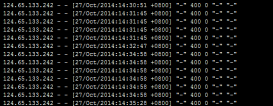周末看了nginx线程池部分的代码,顺手照抄了一遍,写成了自己的版本。实现上某些地方还是有差异的,不过基本结构全部摘抄。
在这里分享一下。如果你看懂了我的版本,也就证明你看懂了nginx的线程池。
本文只列出了关键数据结构和API,重在理解nginx线程池设计思路。完整代码在最后的链接里。
1.任务节点
|
1
2
3
4
5
6
7
8
9
|
typedef void (*CB_FUN)(void *);//任务结构体typedef struct task{ void *argv; //任务函数的参数(任务执行结束前,要保证参数地址有效) CB_FUN handler; //任务函数(返回值必须为0 非0值用作增加线程,和销毁线程池) struct task *next; //任务链指针}zoey_task_t; |
handler为函数指针,是实际的任务函数,argv为该函数的参数,next指向下一个任务。
2.任务队列
|
1
2
3
4
5
6
7
|
typedef struct task_queue{ zoey_task_t *head; //队列头 zoey_task_t **tail; //队列尾 unsigned int maxtasknum; //最大任务限制 unsigned int curtasknum; //当前任务数}zoey_task_queue_t; |
head为任务队列头指针,tail为任务队列尾指针,maxtasknum为队列最大任务数限制,curtasknum为队列当前任务数。
3.线程池
|
1
2
3
4
5
6
7
8
9
10
|
typedef struct threadpool{ pthread_mutex_t mutex; //互斥锁 pthread_cond_t cond; //条件锁 zoey_task_queue_t tasks;//任务队列 unsigned int threadnum; //线程数 unsigned int thread_stack_size; //线程堆栈大小}zoey_threadpool_t; |
mutex为互斥锁 cond为条件锁。mutex和cond共同保证线程池任务的互斥领取或者添加。
tasks指向任务队列。
threadnum为线程池的线程数
thread_stack_size为线程堆栈大小
4.启动配置
|
1
2
3
4
5
6
7
|
//配置参数typedef struct threadpool_conf{ unsigned int threadnum; //线程数 unsigned int thread_stack_size;//线程堆栈大小 unsigned int maxtasknum;//最大任务限制}zoey_threadpool_conf_t; |
启动配置结构体是初始化线程池时的一些参数。
5.初始化线程池
首先检查参数是否合法,然后初始化mutex,cond,key(pthread_key_t)。key用来读写线程全局变量,此全局变量控制线程是否退出。
最后创建线程。
|
1
2
3
4
5
6
7
8
9
10
11
12
13
14
15
16
17
18
19
20
21
22
23
24
25
26
27
28
29
30
31
32
33
34
35
36
37
38
39
40
41
42
43
44
45
46
47
48
49
50
51
52
53
|
zoey_threadpool_t* zoey_threadpool_init(zoey_threadpool_conf_t *conf){ zoey_threadpool_t *pool = NULL; int error_flag_mutex = 0; int error_flag_cond = 0; pthread_attr_t attr; do{ if (z_conf_check(conf) == -1){ //检查参数是否合法 break; } pool = (zoey_threadpool_t *)malloc(sizeof(zoey_threadpool_t));//申请线程池句柄 if (pool == NULL){ break; } //初始化线程池基本参数 pool->threadnum = conf->threadnum; pool->thread_stack_size = conf->thread_stack_size; pool->tasks.maxtasknum = conf->maxtasknum; pool->tasks.curtasknum = 0; z_task_queue_init(&pool->tasks); if (z_thread_key_create() != 0){//创建一个pthread_key_t,用以访问线程全局变量。 free(pool); break; } if (z_thread_mutex_create(&pool->mutex) != 0){ //初始化互斥锁 z_thread_key_destroy(); free(pool); break; } if (z_thread_cond_create(&pool->cond) != 0){ //初始化条件锁 z_thread_key_destroy(); z_thread_mutex_destroy(&pool->mutex); free(pool); break; } if (z_threadpool_create(pool) != 0){ //创建线程池 z_thread_key_destroy(); z_thread_mutex_destroy(&pool->mutex); z_thread_cond_destroy(&pool->cond); free(pool); break; } return pool; }while(0); return NULL;} |
6.添加任务
首先申请一个任务节点,实例化后将节点加入任务队列,并将当前任务队列数++并通知其他进程有新任务。整个过程加锁。
|
1
2
3
4
5
6
7
8
9
10
11
12
13
14
15
16
17
18
19
20
21
22
23
24
25
26
27
28
29
30
31
32
33
34
35
36
37
38
39
40
|
int zoey_threadpool_add_task(zoey_threadpool_t *pool, CB_FUN handler, void* argv){ zoey_task_t *task = NULL; //申请一个任务节点并赋值 task = (zoey_task_t *)malloc(sizeof(zoey_task_t)); if (task == NULL){ return -1; } task->handler = handler; task->argv = argv; task->next = NULL; if (pthread_mutex_lock(&pool->mutex) != 0){ //加锁 free(task); return -1; } do{ if (pool->tasks.curtasknum >= pool->tasks.maxtasknum){//判断工作队列中的任务数是否达到限制 break; } //将任务节点尾插到任务队列 *(pool->tasks.tail) = task; pool->tasks.tail = &task->next; pool->tasks.curtasknum++; //通知阻塞的线程 if (pthread_cond_signal(&pool->cond) != 0){ break; } //解锁 pthread_mutex_unlock(&pool->mutex); return 0; }while(0); pthread_mutex_unlock(&pool->mutex); free(task); return -1;} |
7.销毁线程池
销毁线程池其实也是向任务队列添加任务,只不过添加的任务是让线程退出。z_threadpool_exit_cb函数会将lock置0后退出线程,lock为0表示此线程
已经退出,接着退出下一个线程。退出完线程释放所有资源。
|
1
2
3
4
5
6
7
8
9
10
11
12
13
14
15
16
17
18
19
20
|
void zoey_threadpool_destroy(zoey_threadpool_t *pool){ unsigned int n = 0; volatile unsigned int lock; //z_threadpool_exit_cb函数会使对应线程退出 for (; n < pool->threadnum; n++){ lock = 1; if (zoey_threadpool_add_task(pool, z_threadpool_exit_cb, &lock) != 0){ return; } while (lock){ usleep(1); } } z_thread_mutex_destroy(&pool->mutex); z_thread_cond_destroy(&pool->cond); z_thread_key_destroy(); free(pool);} |
8.增加一个线程
很简单,再生成一个线程以及线程数++即可。加锁。
|
1
2
3
4
5
6
7
8
9
10
|
int zoey_thread_add(zoey_threadpool_t *pool){ int ret = 0; if (pthread_mutex_lock(&pool->mutex) != 0){ return -1; } ret = z_thread_add(pool); pthread_mutex_unlock(&pool->mutex); return ret;} |
9.改变任务队列最大任务限制
当num=0时设置线程数为无限大。
|
1
2
3
4
5
6
7
8
|
void zoey_set_max_tasknum(zoey_threadpool_t *pool,unsigned int num){ if (pthread_mutex_lock(&pool->mutex) != 0){ return -1; } z_change_maxtask_num(pool, num); //改变最大任务限制 pthread_mutex_unlock(&pool->mutex);} |
10.使用示例
|
1
2
3
4
5
6
7
8
9
10
11
12
13
14
15
16
17
18
19
20
21
22
23
24
25
26
27
28
29
30
31
32
33
34
|
int main(){ int array[10000] = {0}; int i = 0; zoey_threadpool_conf_t conf = {5,0,5}; //实例化启动参数 zoey_threadpool_t *pool = zoey_threadpool_init(&conf);//初始化线程池 if (pool == NULL){ return 0; } for (; i < 10000; i++){ array[i] = i; if (i == 80){ zoey_thread_add(pool); //增加线程 zoey_thread_add(pool); } if (i == 100){ zoey_set_max_tasknum(pool, 0); //改变最大任务数 0为不做上限 } while(1){ if (zoey_threadpool_add_task(pool, testfun, &array[i]) == 0){ break; } printf("error in i = %d\n",i); } } zoey_threadpool_destroy(pool); while(1){ sleep(5); } return 0;} |
11.源码
https://github.com/unlikewashface/zoey_threadpool.git
线程池可以发挥更多作用,比如可以把连接放到线程池里。nginx的异步加lua的协程是个非常好的组合,现在有了线程池后,线程池加协程将是另一个选择。总而言之,如果在保证性能的情况下,让nginx开发变得非常简单,这是非常利好的消息。

















